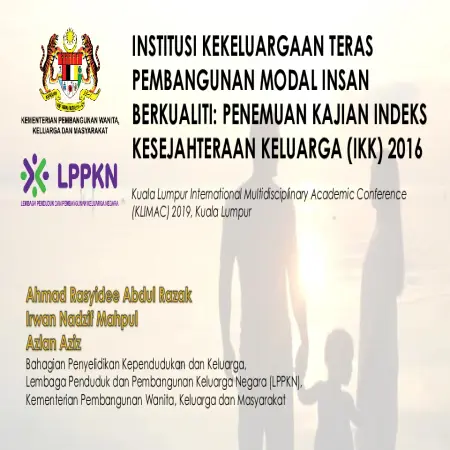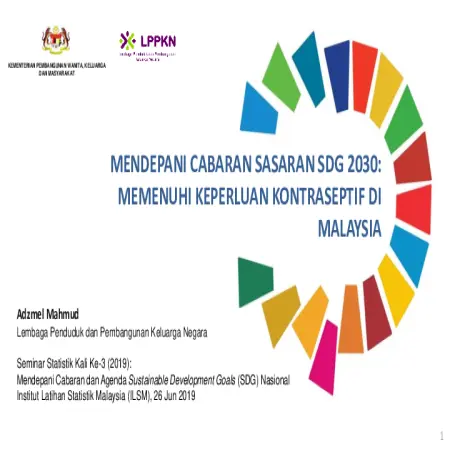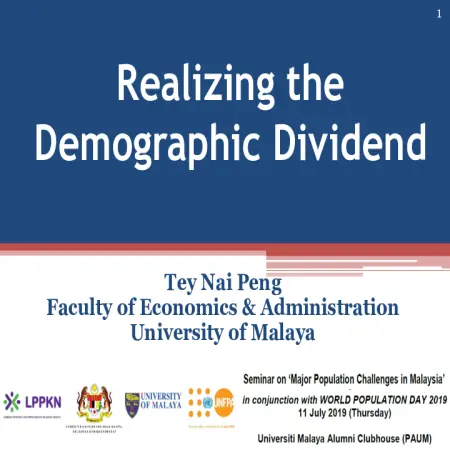TOPICS
|
|
25 Years of the ICPD: reproductive health and rights challenges
Item Type: Conference or Workshop Item
Editor:
Year: 00/00/2019
Abstract: To increase contraceptive prevalence will require strengthening the information, education and skills development of health care providers, repositioning of family planning, more public awareness on benefits and side effects of modern contraceptives, keeping abreast with modern contraceptive technology including LARC, male/boy responsibility programs, better data collection and monitoring including from the young and unmarried, collaboration and coordination with all stakeholders and delivery of quality services to all without discrimination and stigmatization.
|
|
|
|
|
|
Women subjective well-being in Malaysia: findings from Fifth Malaysian Population and Family Survey (MPFS-5)
Item Type: Conference or Workshop Item
Editor:
Year: 00/00/2019
Abstract: This presentation slide aims to measure the subjective well-being of women between age 20 to 59 years old in Malaysia. A total of 8, 171 respondents in the Fifth Malaysian Population and Family Survey (MPFS-5) with different marital status, employment status, ethnic and strata who answered the PWI instrument were analyzed.
|
|
|
|
|
|
Analisis Situasi Kependudukan dan Kekeluargaan di Malaysia
Item Type: Conference or Workshop Item
Editor:
Year: 00/00/2019
Abstract: Population related program or policies have been introduced since 1966 and have gone through 3 series of studies. IN 1966, The National Family Planning Program was able to reduce the population growth rate from 3% per year to 2% (1985). On June 10 1966, LPKN was established under The National Family Planning Act No.42, 1966. The growth rate decreased to 2.8 in 1980. The 70 million population policy was announced in 1984 to reach 70 million population by 2100. This presentation slide describes the findings of the study of the analysis of the population and family situation in Malaysia, including the 7 main challenges of the population which include aspects of fertility, aging, labor force and productivity.
|
|
|
|
|
|
Mendepani cabaran sasaran SDG 2030: memenuhi keperluan kontraseptif di Malaysia
Item Type: Conference or Workshop Item
Editor:
Year: 00/00/2019
Abstract: This paper will present on the trends and achievements of contraceptive use rates, unmet contraceptive requirements and modern contraceptive demands met. In addition, the presentation will also touch on issues and challenges on the rate of contraceptive use which is still hovering around 50 to 52 percent over the past three decades as well as the level of unmet needs in Malaysia which is relatively high compared to other Asean countries.
|
|
|
|
|
|
Realising the demographic dividend
Item Type: Conference or Workshop Item
Editor:
Year: 00/00/2019
Abstract: Malaysia has done well in harnessing the demographic dividend through pragmatic planning and management, and investment in health and education. It is ranked among the very high Human Development index country (from 63 to 57). Achieved almost all the goals of ICPD (1994-2014) and MDGs (2000-2015).
|
|
|
|
|
|
Teen pregnancy and sex education
Item Type: Article
Editor:
Year: 00/00/2019
Abstract: Teenage pregnancy refers to any pregnancy in women or girls aged 19 years or younger. In 2016, the Ministry of Health recorded more than 12,000 teenage pregnancies in Malaysia. The National Registration Department reported that 4,992 children were born out of wedlock to girls aged 18 years and below. Teenage pregnancy is associated with immediate as well as long-term health risks. It is also accompanied by a number of negative consequences that are detrimental to the well-being of young mothers – disruption of education, limitation of opportunities for self-development and employment, social stigma and increased exposure to violence and exploitation. This article examines some circumstances resulting in teenage pregnancy and explores ways to support teenagers who face difficulties resulting from unintended pregnancy.
|
|
|
|














